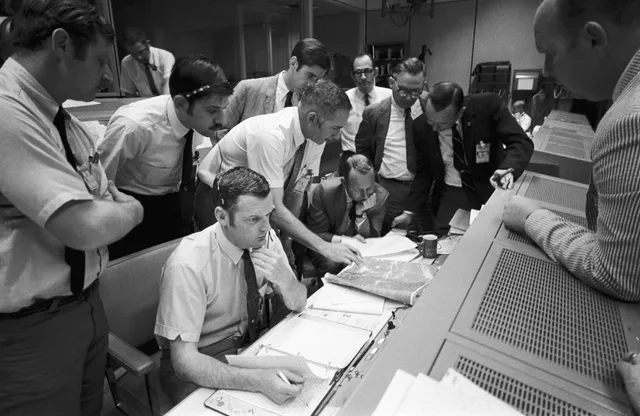Don't let crisis become a compass
Crunch time feels productive. It also reveals problems hiding in plain sight.

On the way to the moon, the crew of Apollo 13 was wrapping up before getting some sleep. One last item on the checklist: stir the oxygen tanks to keep them from freezing. Then came the explosion.
Within seconds, they started losing power. Oxygen supplies dropped, and instrument panels started displaying garbage data. No one knew exactly what happened, but they knew it was serious. "Houston, we've had a problem."
What followed was extraordinary. Instead of panic, Mission Control acted quickly and worked the problem. They managed to repurpose the fragile lunar module as a lifeboat, improvise air scrubbers from duct tape and plastic bags, and calculate new trajectories by hand. All three astronauts survived and returned home. It was a masterclass in collaboration, confidence, and teamwork under pressure.
But no one at NASA mistook those moments for a model of working. Their success wasn't due to how well they worked in a catastrophe, it was a reflection of how they trained for everything before it. The reason they could respond so well was because they didn’t operate in chaos by default. Procedures, simulations, communication rituals, and mutual trust were already in place.
NASA engineers knew that systems built on urgency were fragile. But in tech, we often mistake that urgency for clarity.
Crisis creates a mirage of efficiency
Scaling a business is hard. You launch quickly, building something nimble and basic. In order to grow and attract users, you add more features, more systems. Over time you run into data models that get in the way, code that needs to be refactored, and pages that load soooo slowly. Changing anything risks breaking something, so you develop meetings and process to coordinate work. The team just isn't as fast as they used to be, and you're not sure why. It's frustrating.
All of a sudden, something breaks or there's a critical deadline. Priorities become obvious and your teams step up. It feels like everyone is finally operating at their best, and it can be addictive. The rush of working with urgency is intoxicating, so you start to wonder how to capture some of this magic. Eventually, crunch time becomes how you work all the time.
The problem is, crisis isn’t a sustainable operating model. It only looks like high performance. In reality, it’s adrenaline, fear, and deferred costs. You can’t build a healthy team or a good product by staying in that mode. Even if it appears to work for months, eventually it will crack.
What crisis mode is really telling you
In times of crisis, what you're seeing is not your team at their best. It's a stress response that signals deeper problems. Apollo 13's post-mission analysis revealed that the oxygen tank explosion wasn't just bad luck. The tank had been dropped during manufacturing months earlier, but the damage wasn't properly detected or addressed. Urgency and poor communication about voltage requirements led to testing procedures that made the damage worse. The lesson for NASA wasn't that heroics worked, it was that you need to correct the systemic issues that require them in the first place.
Crunch time does create focus, but it's artificial. When your team suddenly aligns and makes quick decisions, it's clear that great teamwork was always possible. They're also showing you that something is preventing that collaboration when things are more calm.
Maybe it's unclear or shifting priorities. Sometimes teams are unaware of how they complement each other, focused on their own goals instead of a shared vision. Other times it's about a lack of trust or autonomy, having to run decisions through layers of approvals. Crisis has a habit of showing you what's getting in the way.
Speed in crunch time does not replace strategy. Just because decisions get made faster in crunch time doesn’t mean they’re better, or that the process is repeatable. Quick fixes are brittle, often undocumented, and rarely revisited. Root causes are patched over instead of being addressed. Speed alone leads to systems that are invisibly fragile and break at the worst time.
Teams that rely on crisis mode find themselves dealing with the same types of problems over and over. They're treating symptoms, not causes. Each heroic response teaches them to prepare for the next emergency instead of preventing it.
Cultural impact and long term cost
Repeated crisis mode work leads to burnout, brittle systems, and shallow prioritization. It quickly erodes trust, as teams are forced to be reactive and have little agency or time to address deeper issues. That trust is very difficult to rebuild and takes a long time.
The cultural impact of constant urgency can be even more damaging. When heroics get celebrated, it tells the team that speed and sacrifice matter more than thoughtfulness or consistency. That kind of praise rewards those without caregiving duties or outside constraints, and leaves others feeling overlooked. Over time, it creates a culture where visibility beats impact.
Great teams don’t just reward firefighting. They value the people who prevent the fire in the first place.
Even those who consistently go above and beyond don't walk away unscathed. They become seen as the hero, the example everyone else is measured against. Instead of recovery, their hard work is rewarded with more work, more pressure, and fewer boundaries. Once someone proves they know enough to fix a crisis, they become the default person to call for "quick fixes" and troubleshooting. Recognition turns into expectation.
Over time, that can lead to resentment, isolation, or burnout, even in your top performers. And worse, it teaches the team that the only way to be seen is to be in pain. That’s not sustainable, and it’s not leadership.
Crunch time is fine. Sometimes.
None of this means urgency is always wrong. Sometimes a deadline is for a critical sale, or a customer issue really does call for all hands. Needing to rush is unavoidable and can boost productivity. Working together in crunch time helps form bonds and build trust. The problem is when it becomes the default. High-performing teams can shift into high gear when it counts, but they don’t live there. They sprint, recover, and reflect. They make those moments count because they’re rare, intentional, and balanced by a sustainable pace the rest of the time.
Setting a better course
If crisis has become your compass, it’s time to reset. That doesn’t mean slowing down or adding red tape. It means building the kind of foundation that lets your team move quickly without setting fires to get there.
Start by making priorities visible and tradeoffs explicit. If there's a deadline, provide context as to why it exists and make the constraints clear. Encourage your team to ask clarifying questions and suggest alternatives. Don’t create an emergency to force focus. Instead, clearly explain what success looks like and what's not important, then build systems that maintain that clarity.
Revisit your planning rhythms, ensuring each team has a voice and shares expectations. Make sure the plan is flexible, adjusting as you learn. Tighten your feedback loops by establishing regular check-ins that prevent small problems from becoming emergencies. Help the team see what matters most and what can wait.
Next, reward the right things. If you only praise last-minute saves, you’ll keep getting last-minute problems. Make sure to recognize the engineer who reduced incidents, the PM who saw the risk a month out, the designer who caught the complexity before it shipped. Make that kind of foresight just as visible and valuable as triage and repair.
Give your team room to think. A team that’s always in response mode can’t do its best work. Protect their time, helping them prioritize and set aside what's not urgent. Model calm, and give people a rest after crunch time. You’ll get better outcomes and a healthier team.
Most of all, pay attention to the signals. If work only feels aligned when something’s broken, the misalignment was already there. Your job isn’t to make people move faster. It’s to create the conditions where they don’t have to sprint to succeed.
That’s what leadership looks like. Not heroics. Not chaos. Just steady hands on the wheel, helping the team find its true heading and stick to it.


